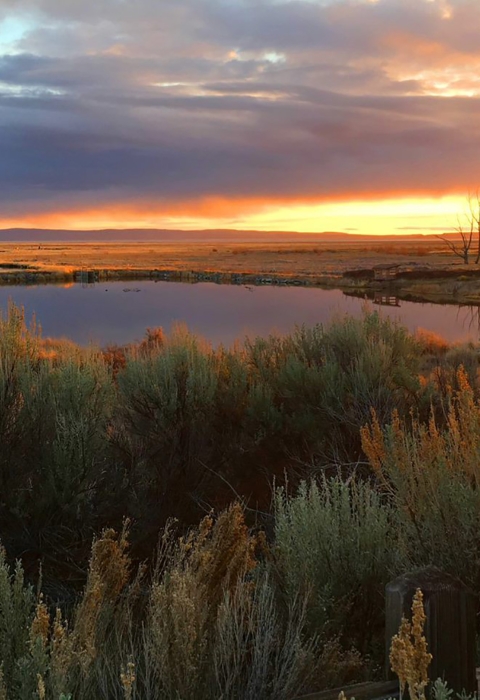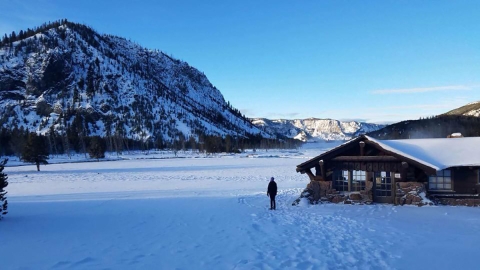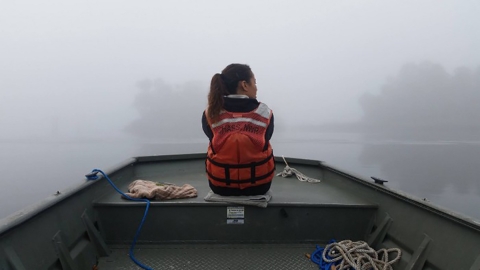In my industry, I am more than a minority… I am a rarity. Professionals as well as participants in the conservation and recreation community overwhelmingly identify as white. As an African American with mixed ancestry I stand out in a crowd.
This has always been a part of my life and it is a fact that I passively accepted. Over the past year however, as the national discourse on racial equality reached a fever pitch, I began to reflect on my own sphere and unpack the homogeneity in my industry in order to help change the status quo and open conservation and recreation to all groups.
The outdoors are for everyone! Unmatched beauty and experiences can be found on our public lands. It was a cold but breathtaking day hiking in Yellowstone National Park, Wyoming. Photo By: David Jankowski
According to the 2019 US Census Estimate, African Americans comprise 13.4% of the national population. Despite this, African Americans only represented 1% of visitors to national parks, national forests, or national wildlife refuges while nearly 95% of visitors were white. From my own personal observations, the vast majority of my agency coworkers are white and I am very aware that I look different from my peers. In reviewing this data, I can’t help but wonder why this is the case.
Why are black people underrepresented as conservation professionals and participants compared to the national distribution? This is undoubtedly and extremely complex issue, but one reason lies in the optics of what it means to be a conservation professional or an outdoor enthusiast. Culturally, we as a society associate environmentalism with whiteness and privilege, and those who participate who do not fit this mold become a novelty that stands out. I can tell you from experience there is no faster way to make someone feel unwelcome in a new setting than feeling as though you don’t look the part.
We saw the power of prejudice when the #BirdingWhileBlack movement grew after Christian Cooper, a black man who also happened to be a birder, was accosted by a white woman who used his race as a weapon to intimidate him into submission. While her efforts failed, the encounter highlighted how the image of black people in the outdoors can often make people uncomfortable and this fear and discomfort can lead to acts of violence or intimidation.
While speaking to a family member recently, I asked him why he never goes hiking or camping and why his family never took him when he was a kid. His response was swift and decisive: “we didn’t feel welcome or safe outside of our neighborhood.” My family members did not feel wanted in rural settings or in outdoor spaces because they were seen as outsiders, and this lack of safety and inclusion was a major barrier to participation. My family members sensed the same animosity when they left their urban community, and so over time our family traditions evolved to exclude those unsafe spaces. Growing up we didn’t hunt, we didn’t camp or hike, we didn’t go birding, we didn’t fish, and we didn’t get to enjoy the natural world because threats of violence took away any joy from those activities.
My family member’s response and Christian Cooper’s encounter resonated deeply with me. I love riding horses and running, and spending time in the country is among my favorite pastimes. I can remember many instances when I have been out jogging on rural roads or visiting farms and people will walk outside and stare at me suspiciously as I pass. Other times I have had drivers yell racial slurs at me while speeding by. I started carrying pepper spray for personal protection because my skin color made me a target.
I want to change this. I love the wildlife and plants that create the unspeakable beauty of this planet and I want others to enjoy nature as well. To my peers in the BIPOC community: we are welcome on public lands and the conservation and recreation world is open to all who wish to participate. As discussion on racial equality have become more mainstream in recent months, it has encouraged many to vocalize their experiences and this bravery has helped me to realize that it is my responsibility to challenge stereotypes no matter the venue and no matter the situation. I encourage all members of the minority community as well as supporters from the majority to do the same. There can be no change in silence. Inaction is silence.
[insert image here]
Left: Hiking near Kohala National Forest Reserve, Hawaii. Photo Credit: David Jankowski. Right: Enjoying Yellowstone National Park. Photo credit: Karen Jankowski
To all who have felt unwelcome or who have questioned whether or not this world was for them, it is for all of us. Recreate and reinvent what it means to “look the part” in conservation by participating and breaking down the cultural barriers ahead of you. Let’s work together to change these images for kids and future generations who may never have thought this world was open to them. If you dream of being a wildlife biologist or if you want to explore public lands in your area, there are resources out there to connect you and your community with the outdoors.
Here are a few:
- USFWS Jobs and Internships (add link here later)
- USFWS Urban Wildlife Conservation Program (add link here later)
- Identify a national wildlife refuge national wildlife refuge
A national wildlife refuge is typically a contiguous area of land and water managed by the U.S. Fish and Wildlife Service for the conservation and, where appropriate, restoration of fish, wildlife and plant resources and their habitats for the benefit of present and future generations of Americans.
Learn more about national wildlife refuge near you (add link here later) - National Recreation Resources
- Portland Metro Park Finder
- Northwest Family Daycation
[insert image here] [insert image here]






